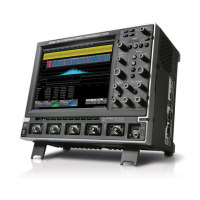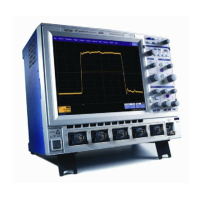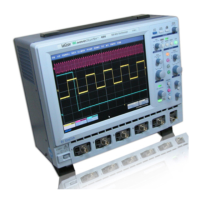X-Stream Operator’s Manual
WM-OM-E Rev I 375
transitions are allowed. When d=1, adjacent transitions are not permitted. For E2PR4 it can
also be set to d=2. A non-zero d eliminates several possible sequence choices (states and
transitions in the Viterbi detector). If set to 1 when it should be 0, Channel Emulation
without Reference will almost certainly detect a large number of "errors." If set to 0 when it
should be 1, it is possible that Channel Emulation without Reference will pass a few bits
that should have been flagged as errors.
Channel Emulation with Reference
Whereas Channel Emulation without Reference acquires a single trace and makes a prediction of
problems based on signal quality, when the method is used with a reference signal, it calculates the
Viterbi output of the reference, as well as that of the acquired trace, and compares the two to find
mismatches.
Channel Emulation with Reference starts by finding the beginning of the sector. The algorithm
looks at the head signal beginning at the Read Gate true transition (or analyze region start if Read
Gate is not available) and tries to synchronize to the VCO Synch pattern in order to establish
sampling phase and expected sample levels. To accomplish this, Channel Emulation with
reference requires that VCO Synch Pattern be set correctly, and that the Bit Cell Time be
approximately correct. Because the position of Read Gate relative to the head signal can jitter from
read to read, the method aligns the two bit streams it is comparing based on the end of the
repetitive VCO Synch pattern. If there is an error within the VCO Synch pattern, this will be found,
but the method may also find many other mismatches if incorrectly aligned.
The data is then passed through the emulated channel where it is appropriately sampled. The
sampled output enters the Viterbi detector, which chooses the "sequence" of bits (history) that is
the most likely when the new bit due to this sample is appended.
SAM is the margin between keeping and rejecting the correct state in the sequence, at any point.
Channel Emulation without reference essentially assumes that the output of the Viterbi detector is
"correct," and gives the margin between that and a different decision at each bit position. It must do
this because it does not have a reference. Therefore SAM results are always greater than zero from
Channel Emulation without reference --- they are the margin from the final decision to some other
decision.
Channel Emulation with reference performs channel emulation on the reference signal when it is
stored and saves the resulting bit sequence. When "Emulation" is turned on it performs channel
emulation on each subsequent acquisition and looks at the margin for the states in the final
surviving state of the reference bit sequence. As long as the bit sequence for the current acquisition
and the reference acquisition match, the margin is > 0. When a different decision is actually made
the margin reported is less than zero: there was less then zero margin to making a different
decision; a different decision was actually made. Even if both signals are of excellent quality, but
different, Channel Emulation with a Reference signal will catch it.
This divergence of paths through the detector may be referred to as an "error event." After a very
few bits, typically, the paths converge again. The SAM reported for the bit where the paths
converge will also be negative. This is because the reference and acquisition disagree on the
previous bit, and the state of the detector reflects the current bit and at least one previous bit (for
PR4).
